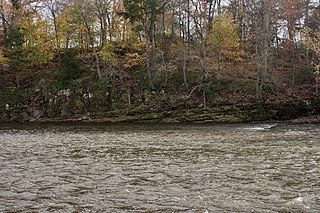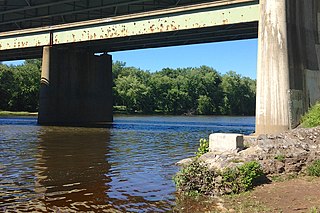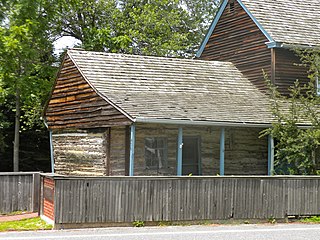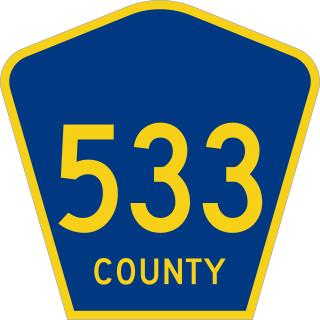
U.S. Route 206 is a 130.2-mile-long (209.5 km) north–south U.S. highway in New Jersey and Pennsylvania, United States. Only about a 1⁄2 mile (0.80 km) of its length is in Pennsylvania; the Milford–Montague Toll Bridge carries it over the Delaware River into New Jersey, where it connects to the remainder of the route. Its southern terminus is at an intersection of White Horse Pike and Bellevue Avenue in Hammonton. The highway's northern terminus is at an intersection of US 209 near Milford, Pennsylvania; some sources and signs show an overlap with US 209 to end at its parent route US 6. For much of its length, US 206 is a rural two-lane undivided road that passes through the Pine Barrens, agricultural areas, and the Appalachian Mountains of Northwestern New Jersey, with some urban and suburban areas. The route connects several cities and towns, including Bordentown, Trenton, Princeton, Somerville, Roxbury, Netcong, and Newton.

West Jersey and East Jersey were two distinct parts of the Province of New Jersey. The political division existed for 28 years, between 1674 and 1702. Determination of an exact location for a border between West Jersey and East Jersey was often a matter of dispute.

The Province of East Jersey, along with the Province of West Jersey, between 1674 and 1702 in accordance with the Quintipartite Deed, were two distinct political divisions of the Province of New Jersey, which became the U.S. state of New Jersey. The two provinces were amalgamated in 1702. East Jersey's capital was located at Perth Amboy. Determination of an exact location for a border between West Jersey and East Jersey was often a matter of dispute.

George Keith was a Scottish religious leader, a Presbyterian turned Quaker turned Anglican. He was born in Peterhead, Aberdeenshire, Scotland, to a Presbyterian family and received an M.A. from the University of Aberdeen. Keith joined the Religious Society of Friends (Quakers) in the 1660s, accompanying George Fox, William Penn, and Robert Barclay on a mission to the Netherlands and Germany in 1677.

The Raritan River is a river of the U.S. state of New Jersey. Its watershed drains much of the mountainous areas in the northern and central sections of the state, emptying into the Raritan Bay near Staten Island on the Atlantic Ocean.

The Delaware and Raritan Canal is a canal in central New Jersey, built in the 1830s, that connects the Delaware River to the Raritan River. It was an efficient and reliable means of transportation of freight between Philadelphia and New York City, transporting anthracite coal from eastern Pennsylvania during much of the 19th and early 20th centuries. The canal allowed shippers to cut many miles off the existing route from the Pennsylvania Coal Region down the Delaware, around Cape May, and up the occasionally treacherous Atlantic Ocean coast to New York City.

The Province of New Jersey was one of the Middle Colonies of Colonial America and became the U.S. state of New Jersey in 1776. The province had originally been settled by Europeans as part of New Netherland but came under English rule after the surrender of Fort Amsterdam in 1664, becoming a proprietary colony. The English renamed the province after the island of Jersey in the English Channel. The Dutch Republic reasserted control for a brief period in 1673–1674. After that it consisted of two political divisions, East Jersey and West Jersey, until they were united as a royal colony in 1702. The original boundaries of the province were slightly larger than the current state, extending into a part of the present state of New York, until the border was finalized in 1773.

The Twelve-Mile Circle is an approximately circular arc that forms most of the boundary between Delaware and Pennsylvania. It is a combination of different circular arcs that have been feathered together.

The Millstone River is a 38.6-mile-long (62.1 km) tributary of the Raritan River in central New Jersey in the United States.

The Line of Property is the name commonly given to the line dividing Indian lands from those of the Thirteen Colonies, which were established in the 1768 Treaty of Fort Stanwix between British officials and the Iroquois tribes. In western Pennsylvania, it is referred to as the Purchase line.

The New York–Pennsylvania border is the state line between the U.S. states of New York and Pennsylvania. It has three sections:

European colonization of New Jersey started soon after the 1609 exploration of its coast and bays by Henry Hudson. Dutch and Swedish colonists settled parts of the present-day state as New Netherland and New Sweden.
Gawen Lawrie was a deputy governor of the American province of East Jersey from 1683 to 1686.

County Route 533 is a county highway in the U.S. state of New Jersey. The highway extends 32.7 miles (52.6 km) from the White Horse Circle, in Hamilton to Lincoln Boulevard on the border of Bound Brook and Middlesex Borough. CR 533 shares a long concurrency with US 206 through Princeton and Montgomery, while portions of the roadway in Somerset County are part of the Millstone River Valley Scenic Byway.
Newton Township is a defunct township that was located in Sussex County, in northwestern New Jersey, in the United States. The township was established as a precinct in 1751, the township is first mentioned in a description of its boundaries in the sessions of the Court of Common Pleas in Morris County. Before the establishment of Sussex County on 8 June 1753, Morris County controlled the sparsely populated areas in the northwestern corner of New Jersey and spanned the territory of three present-day New Jersey counties: Morris, Sussex, and Warren. After ceding territory on several occasions new municipalities were created, Newton Township ceased to exist on 11 April 1864.

The New York – New Jersey Line War was a series of skirmishes and raids that took place for over half a century between 1701 and 1765 at the disputed border between two American colonies, the Province of New York and the Province of New Jersey.

The Penn–Calvert boundary dispute was a long-running legal conflict between William Penn and his heirs on one side, and Charles Calvert, 3rd Baron Baltimore and his heirs on the other side. The overlapping nature of their charters of land in Colonial America required numerous attempts at mediation, surveying, and intervention by the king and courts of England to ultimately be resolved. Subsequent questions over these charters have also been adjudicated by American arbitrators and the Supreme Court of the United States. The boundary dispute shaped the eventual borders of five U.S. states: Pennsylvania, Maryland, Delaware, New Jersey, and West Virginia.
















